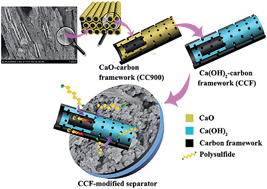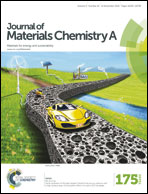Modified separators coated with a Ca(OH)2–carbon framework derived from crab shells for lithium–sulfur batteries†
Abstract
Lithium–sulfur (Li–S) batteries have been considered as promising candidates for next-generation energy storage owing to the remarkably high theoretical specific capacity and energy density of sulfur. However, the shuttle effect of lithium polysulfides hampers their commercial application. Here, a Ca(OH)2–carbon framework derived from crab shells is successfully used to design a modified separator for Li–S batteries. Benefiting from the effective dispersal of Ca(OH)2 in the conductive carbon framework, the Ca(OH)2–carbon framework confers two benefits: first, it facilitates electron and ion transfer during redox reactions, and second, it efficiently traps the dissolved polysulfides. An enhanced Li–S performance is achieved by the utilization of a Ca(OH)2–carbon framework-modified separator, resulting in an initial capacity of 1215 mA h g−1 and a high reversible capacity of 873.5 mA h g−1 after 250 cycles at a rate of 0.5C. The results of this work show that Ca(OH)2–carbon frameworks derived from crab shells could be promising nanostructured materials to improve the performance of Li–S batteries.


 Please wait while we load your content...
Please wait while we load your content...